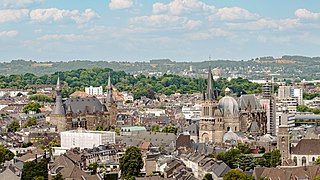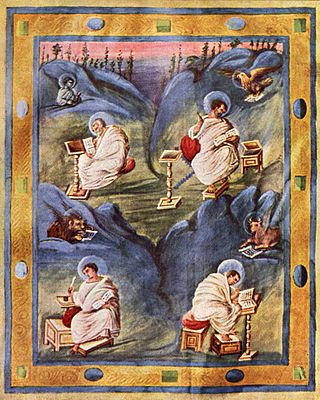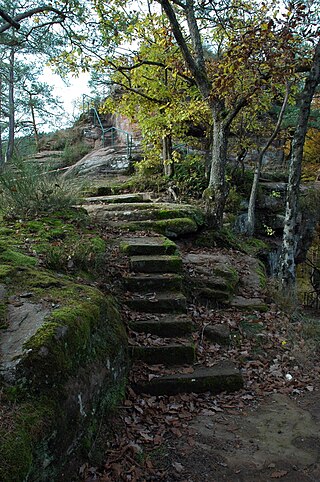
Aachen is the 13th-largest city in North Rhine-Westphalia and the 27th-largest city of Germany, with around 261,000 inhabitants.

The Château de Coucy is a French castle in the commune of Coucy-le-Château-Auffrique, in Picardy, built in the 13th century and renovated by Eugène Viollet-le-Duc in the 19th century. During its heyday, it was famous for the size of its central tower and the pride of its lords, who adopted the staunchly independent rhyme: roi ne suis, ne prince ne duc ne comte aussi; Je suis le sire de Coucy.

Alfred Dregger was a German politician and a leader of the Christian Democratic Union (CDU).

Eugen Gustav Dücker was a Baltic German painter, in the Romantic style, associated with the Düsseldorfer Malerschule.

Bergfried is a tall tower that is typically found in castles of the Middle Ages in German-speaking countries and in countries under German influence. Stephen Friar in the Sutton Companion to Castles describes a bergfried as a "free-standing, fighting-tower". Its defensive function is to some extent similar to that of a keep in English or French castles. However, the characteristic difference between a bergfried and a keep is that a bergfried was typically not designed for permanent habitation.

The Sporkenburg is a late medieval castle ruin about one kilometre south of Eitelborn in the district of Westerwaldkreis in the German state of Rhineland-Palatinate.

The Aachen Gospels are a Carolingian illuminated manuscript which was created at the beginning of the ninth century by a member of the Ada School. The Evangeliary belongs to a manuscript group which is referred to as the Ada Group or Group of the Vienna Coronation Gospels. It is part of the church treasury of Charlemagne's Palatine Chapel, now Aachen Cathedral, and is today kept in the Aachen Cathedral Treasury. The Treasury Gospels and the more recent Ottonian Liuthar Gospels are the two most significant medieval manuscripts on display there.

The Wilgartaburg, also called the Wiligartaburg, Wilgartsburg or Wiligartisburg, is the heritage site of a ruined rock castle located at a height of 245 m above sea level (NN) near the German village of Wilgartswiesen in the state of Rhineland-Palatinate.

The Bernward Doors are the two leaves of a pair of Ottonian or Romanesque bronze doors, made c. 1015 for Hildesheim Cathedral in Germany. They were commissioned by Bishop Bernward of Hildesheim (938–1022). The doors show relief images from the Bible, scenes from the Book of Genesis on the left door and from the life of Jesus on the right door. They are considered a masterpiece of Ottonian art, and feature the oldest known monumental image cycle in German sculpture, and also the oldest cycle of images cast in metal in Germany.

The Royal Palace of Werla is located near Werlaburgdorf in Lower Saxony. The grounds of the royal palace cover about 20 hectares rising atop Kreuzberg hill, a 17 m high natural plateau overlooking the Oker river. In the Early Middle Ages the palace was an important place in the Holy Roman Empire, serving as an important base for the Ottonians in the 10th century in particular. Although it subsequently lost its political significance to the newly established Imperial Palace of Goslar at Rammelsberg, it developed into an independent settlement with a busy industrial quarter. In the 14th century it fell into ruin and was completely unknown until its rediscovery in the 18th century. The core fortress in particular was thoroughly excavated in the 20th century. Excavations carried out since 2007 have brought new understanding to the hitherto largely unexplored outworks. Since 2010 the palace complex with foundation and enceinte, as well as earthworks, has been partially reconstructed and is now open to the public as the Archäologie- und Landschaftspark Kaiserpfalz Werla.

Counter-castles were built in the Middle Ages to counter the power of a hostile neighbour or as a siege castle, that is, a fortified base from which attacks could be launched on a nearby enemy castle.

The Brömserburg is a castle located near the banks of the Rhine in the town of Rüdesheim am Rhein in Rheingau-Taunus-Kreis in the German state of Hesse. Its original structure was probably one of the first stone castles in the Rhine Gorge, now a UNESCO World Heritage Site.

Wernerseck Castle, also called the Kelterhausburg, is a late medieval hill castle in the municipality of Ochtendung in the county of Mayen-Koblenz in the German state of Rhineland-Palatinate. It owes its name to its founder and lord of the castle, the Archbishop of Trier, Werner of Falkenstein (1388–1418). "Wernerseck" means "Werner's corner".

The ruins of Nideggen Castle are a symbol of the town of Nideggen in Germany and are owned by the county of Düren. The rectangular hill castle was the seat of the powerful counts and dukes of Jülich and had a reputation in the Middle Ages of being impregnable.

Auersburg Castle is a ruined hill castle in parish of Hilders in the county of Fulda in Hesse, Germany. The site is used today as a shelter and viewing platform.

Haselstein Castle is a ruined hill castle near the village of Haselstein in Nüsttal in the county of Fulda in Hesse, Germany. It lies next to the village on a steep basalt cone at a height of 434 m above sea level (NN). The rock was first mentioned in 780/781 as the Haselahastein.

Treis Castle, also called Treisburg, is a castle ruin in the municipality of Treis-Karden on the Moselle in the district of Cochem-Zell in the state of Rhineland-Palatine in Germany. It is located 30 kilometres south-west of the city of Koblenz.
Carl (Karl) Adloff was a German painter of the Düsseldorf school of painting.
This page is based on this
Wikipedia article Text is available under the
CC BY-SA 4.0 license; additional terms may apply.
Images, videos and audio are available under their respective licenses.
























